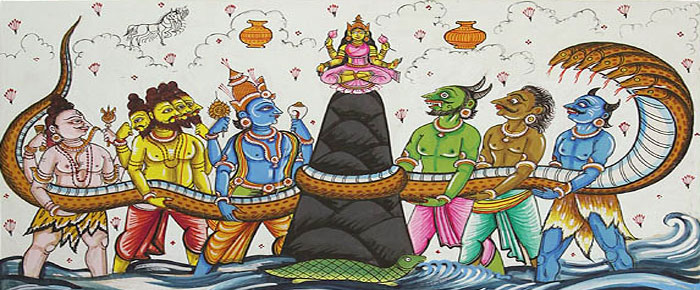
Churning of the Ocean of Existence
The observance of Kumbhamela is based on the Hindu myth of the beating of the ocean of milk. In ancient times, the devas (gods) and the asuras (demons) made a provisional alliance to work together in the making of amrita, the nectar of immortality, with the help of Kshîra Sagara, the primordial ocean of milk, and later share it with them. However, when the god Dhanvantai appeared with the kumbha (the pot that contained the elixir), the demons grabbed it from him and fled far away pursued closely by the gods. During twelve divine days and nights (the equivalent of twelve human years), the gods and the demons fought in the sky for the possession of the elixir pot. During the battle, some drops of the elixir spilt in four places: Praiag, Haridwar, Ujjain and Nasik, and this is the reason that these cities are considered sacred and places where the Kumbhamela is celebrated.
There are two important stories regarding the origin of Kumbh Mela. Both of them are traced back to the Puranas. The most important and widely accepted myth starts in the Bhagavatha Purana.
Puranas are filled with wars between Devas (demigods) and Asuras (demons). The Devas always have the upper hand but occasionally due to some curse or misdeeds the Devas lose this upper hand.
Lord Indra, the king of Devas, was once cursed by Sage Durvasa and as a result of this curse, the Demons overpowered the Devas.
To find a solution, the Devas approached Lord Vishnu. Lord Vishnu advised them to obtain Amrut - ‘the nectar of immortality.’
So to obtain the Amrut, the Devas decided to churn the ocean of existence using Mandara Mountain as the churning rod and Vasuki, the serpent, as the rope. Even though the Devas didn´t want to share the Amritan with the Asuras (demons), they ended up coaxing them and managed to convince them to hold on to Vasuki at one end, while they took the other end.
The churning started and the ocean started to yield divine gifts and the amrut was the last to appear. Dhanvantari, the physician of the gods, appeared with Amrut. The Asuras took the Amrut and started to run away. A fight between the Devas and Asuras ensued.
All the myths associated with Kumbh Mela are the same till this point. But the story changes from this point in different myths.
In the first version of the Skanda Purana, it is suggested that Indra’s son Jayanta got hold of the Amrut during the fight between the Devas and Asuras. He started to run away with it. The demons started to chase Jayanta around the earth. The chase lasted for 12 days or 12 human years. One day of devas is equal to one human year. During this time, the nectar spilled at Allahabad, Haridwar, Nasik and Ujjain.
The second version of the Kumbha Mela appears in Vishnu Purana, Brahmananda Purana, Padma, Agni PuranaMahabharata Ramayana. It suggests that as soon as Dhanvantari appeared with Amrut, Lord Vishnu passed it to Garuda – the mythical bird and vehicle of Lord Vishnu. The Asuras chased Garuda for 12 days or 12 human years, and then Garuda stopped or the nectar spilled at Allahabad, Haridwar, Nasik and Ujjain.
|


